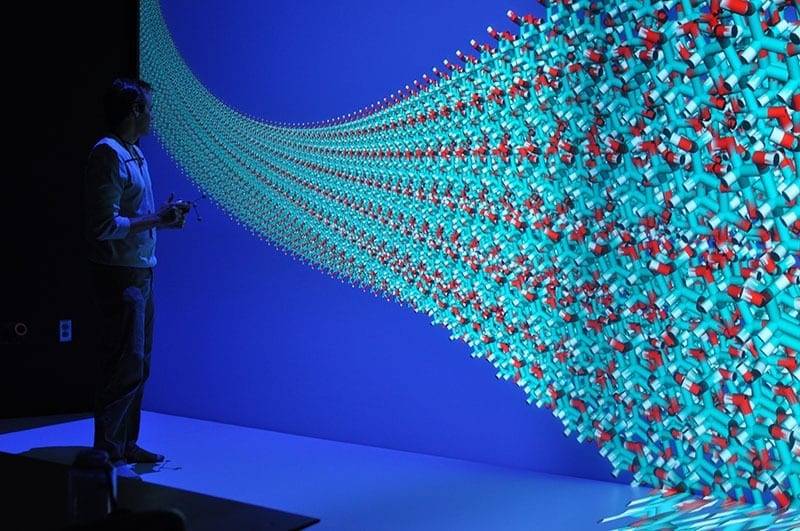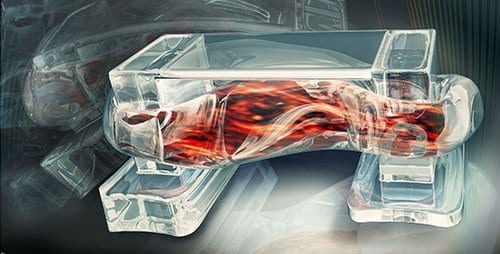
“Big data” is playing an increasingly big role in the renewable energy industry and the transformation of the nation’s electrical grid
“Big data” is playing an increasingly big role in the renewable energy industry and the transformation of the nation’s electrical grid, and no single entity provides a better tool for such data than the Energy Department’s Energy Systems Integration Facility (ESIF) located on the campus of the National Renewable Energy Laboratory (NREL). Imagined by NREL leaders who foresaw the possibilities for high performance computing (HPC), the ESIF’s HPC data center is fulfilling the goal of handling large and complex datasets that exceed traditional database processes.
“As industry moves forward to integrate all these renewables, big data is a key piece of the puzzle,” ESIF Business Development Manager Martha Symko-Davies said. “The links between modeling and simulation, hardware, and good, bad, and aggregated data—all parts of the whole puzzle—are captured at the ESIF through big data.” That’s why the ESIF’s Peregrine supercomputer, dedicated by Energy Secretary Ernest Moniz in September 2013, is so important; it can do more than a quadrillion calculations per second as part of the world’s most energy-efficient HPC data center.
“Peregrine provides much-needed computational capability to model complex systems such as the grid, to allow us to ask ‘what if’ questions, and to optimize how these systems are designed and deployed with much higher confidence in their efficiency and robustness,” NREL Computational Science Center Director Steve Hammond said.
Increasingly, those “what ifs” involve the challenge of delivering distributed energy to the grid when the sun shines and the wind blows, while making it even more reliable than when the grid was a one-way delivery system of fossil-fuel-based energy. “By focusing on the integration and optimization of energy systems across the energy infrastructure, we can better understand and make use of potential co-benefits that increase reliability and performance, reduce cost, and minimize environmental impacts,” NREL Director of Energy Systems Integration (ESI) Ben Kroposki said.
Read more . . .
The Latest on: Balancing the electrical grid
[google_news title=”” keyword=”Balancing the electrical grid” num_posts=”10″ blurb_length=”0″ show_thumb=”left”]
via Google News
The Latest on: Balancing the electrical grid
- Future-Proofing the Electric Grid While Seeking Carbon Cutson May 7, 2024 at 9:18 am
The batteries use iron oxidation to store as well as release energy and help deliver power for 100 hours to keep the grid stable when required. New natural-gas burning turbines to cover peak demand ...
- Making the power grid 'smart' could save us all money and prevent blackouts. Chattanooga made the $280 million investment.on May 2, 2024 at 2:00 pm
The electric grid in Chattanooga, Tennessee, is one of the smartest in the nation. It's a peek at the ultraresilient power system of the future.
- BGE adds partner to help manage MD electricity grid in peak usage monthson May 1, 2024 at 11:18 am
Listen to this article BGE Wednesday announced a partnership with Resideo Technologies to help the Maryland electric and natural gas utility better balance the state’s power grid during times of peak ...
- Building the power grid of tomorrowon April 30, 2024 at 8:20 am
Modernizing infrastructure improves flexibility, reliability, efficiency, sustainability and cybersecurity. It enables large-scale adoption and integration of renewable distributed energy resources ...
- Electrical grid adding some iron to its dieton April 29, 2024 at 3:05 am
Iron poles last about 80 years, stand up to Michigan’s harsh weather, and don’t attract pests, says Consumers Energy of their $3.5M purchase.
- Best Power Grid Expansions In 2024on April 25, 2024 at 5:00 am
Power Grid: Russia/Japan Expansion offers strategic depth for seasoned players. In Russia, a limited power plant market and unique plant retirement rules demand clever tactics. Conversely, Japan's ...
- How Nixon can secure our electricity grid from beyond the graveon April 24, 2024 at 2:38 pm
The Biden administration’s new vehicle rules accelerate electrification just as artificial intelligence and manufacturing are spiking electricity demand.
- Balancing La. homeowner insurance and increasing electricity bill rateson April 23, 2024 at 7:45 am
The Louisiana Public Service Commission approved Phase I for a $1.9 billion plan on Friday (April 19) that will harden Entergy’s power grid. But this will come with a cost for residents across the ...
- The Best Off-Grid Solar Systems of 2024on May 5, 2023 at 5:17 pm
These components are sometimes known as the Balance of System (BoS). Off-grid solar systems offer an excellent power source when you don’t have access to the grid, making them popular among ...
- It's No Stretch, The U.S. Electric Grid Needs Flexibility To Decarbonizeon June 29, 2017 at 6:00 am
The ironclad rule of electricity systems is that supply and demand must remain in perfect balance. A flexible system ... heating and cooling devices to grid operations, implementing time-varying ...
via Bing News










